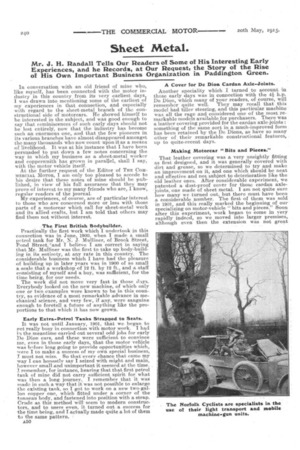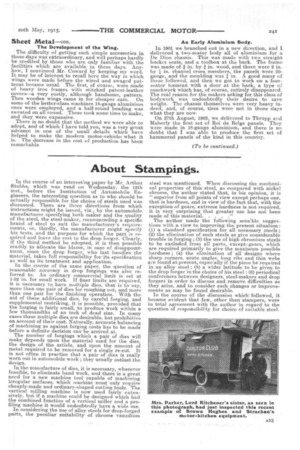Sheet Metal.
Page 18

Page 19

If you've noticed an error in this article please click here to report it so we can fix it.
Mr. J. H. Randall Tells Our Readers of Some of His Interesting Early Experiences, and he Records, at Our Request, the Story of the Rise of His Own Important Business Organization in Paddington Green.
In conversation with an old friend of mine who, like myself, has been connected with the motor industry in this country from its very earliest. days, I was drawn into mentioning some of the earliest of my experiences in that connection, and especially with regard to the sheet-metal branch of the constructional side of motorcars. He showed himself to be interested in the subject, and was good enough to say that reminiscences of such early days should not be lost entirely, now that the industry has become such an enormous one, and that the few pioneers in its various branches have almost disappeared amongst the many thousands who now count upon it as a means of livelihood. It was at his instance that I have been persuaded to put down a few notes concerning the way in which my business as a sheet-metal worker and coppersmith has grown in parallel, shall I say, with the motor vehicle itself.
At the further request of the Editor of THE COMMERCIAL MOTOR, I am only too pleased to accede to his desire that these notes of mine should be published, in view of his full assurance that they may prove of interest to my many friends who are, I know, regular readers of the journal.
My experiences, of course, are of particular interest to those who are concerned more or less with those parts of a motorcar which call for sheet-metal work and its allied crafts, but I am told that others may find them not without interest.
The First British Bodybuilder.
Practically the first work which I undertook in this connection was in June, 1900, when I made a small petrol tank for Mr. N. J. Mulliner, of Brook Street, Pond Street. 'and I believe I am correct in saying that, Mr. MuHiner was the first to take up body-building in. its entirety, at any rate in this country. The considerable business which I have had the pleasure of building up in later years was in 1900 of so small a scale that a workshop of 12 ft. by 12 ft., and a staff consisting of myself and a, boy, was sufficient, for the time being. for our needs.
The work did not move very fast in those days. Everybody looked on the new machine, of which only one or two examples were known to be in this country, as evidence of a most remarkable advance in mechanical science, and very few, if any, were sanguine enough to foretell a future of anything like the proportions to that which it has now grown.
Early Extra-Petrol Tanks Strapped to Seats.
It was not until January, 1901, that we began to eet really busy in connection with motor work. I had in the meantime carried out several odd jobs for early De Dion cars, and these were sufficient to convince me, even in those early days, that the motor vehicle was before long going to provide opportunities which, were I to make a success of my own special business, I must not miss. So that every chance that came my way I can honestly say I seized with might and main, however small and unimportant it seemed at the time. I remember, for instance, hearing that that first petrol tank of mine did not carry sufficient spirit for what was then a long journey.. I remember that it was made in such a way that it was not possible to enlarge the existing tank, so I got to work on a new two-gallon copper one, which fitted under a corner of the tonneau body, and fastened into position with a strap. Crude as this method will seem to modern constructors, and to users even, it turned out a success for the time being. and Tactually made quite a lot of them to the same pattern.
A50 A Cover for De Dion Cardan Axle-Joints.
Another speciality which I turned to account in those early days was in connection with the 4i h.p. De Dion, which many of your readers, of course, will remember quite well. They may recall that this model had tiller steering, and this particular machine was all the rage and considered one of the most remarkable models available for purchasers. There was a leather covering provided for the cardan axle-joints : something of the same sort in a much-improved form has been retained by the De Dions, as have so many other of their remarkable construetional features, up to quite-recent days.
Making Motorcar "Bits and Pieces."
That leather covering was a very unsightly fitting as first designed, and it was generally covered with dirt and grease, so We determined to try and make an improvement on it, and one which should be neat and effective and not subject to deterioration like the old leather ones. After considerable experiment, we patented a dust-proof cover for those cardan axlejoints, one made of sheet metal. I am not quite sure how many we turned out, but there must have been a considerable number. The first of them was sold in 19017 and this really marked the beginning of our specializing on motor-vehicle " bits and pieces." Soon after this experunent, work began to come in very rapidly indeed, so we moved into larger premises, although even then the extension was not great The Development or the Wing.
The difficulty of getting such simple accessories in those days was extraordinary, and will perhaps hardly be credited by those who are only familiar with the facilities which are available in these days. Anyhow, I convinced Mr. Coward by keeping my word. It may be of interest to recall here the way in which wings were made before the wired and swaged patterns became usual. The first, of course, were made of heavy iron frames with stitched patent-leather covers—a very costly, although handsome, pattern. Then wooden wings came in for cheaper cars. On some of the better-class machines 18-gauge aluminium ones were employed, and a half-round beading was sweated on all round. These took some time to make, and they were expensive. There is no doubt that the method we were able to adopt, and of which I have told you, was a very great advance in one of the small .details which have helped to make the modern motor-vehicle k what it is. The decrease in the cost of production has been remarkable An Early Aluntinium Body.
In 1901 we branched out in a new direction, and 1 delivered a two-seater body all of aluminium for a De Dion chassis. This was made with two straight bucket seats, and a, toolbox at the back. The frame was made of in. by in. wood, and there were 2 in. by in. channel cross members, the panels were 20gauge' and the moulding was in. A good many of these followed, and then we got to work on a fourseater tonneau with a door at the back, a type of coachwork which has, of course, entirely disappeared. The real reason for the makers asking for this class of bodywork was undoubtedly their desire to save weight. The chassis themselves were very heavy indeed' and, of course, tires were not in those days what they are now. On 27th August, 1902, we delivered to Thrupp and. Maberly the first eet of Roi de Beige panels. They were made in 18-gauge aluminium, and there is no doubt that I was able to produce the first set of hammered panels of the kind in this country.






















